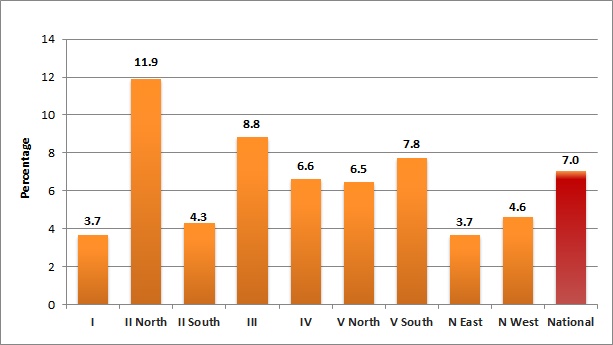 INTRODUCTION
INTRODUCTION
WHEAT
Triticum aestivum L.
The 2016/17 wheat growing season once again was marked by high yields in the main growing areas and by protein levels above those registered in the previous season, reaching almost 1%.
| |||||||||||||||||||||||||||||||||||||||||||||||||||||||||||||||||||||||||||||||||||||||
National production is estimated at 18.34 million tons, up 62.9% from 2015/16 season that reached 11.26 million tons. The average national yield was 3,308 kg/hectare, up 444 kg/ha from last season average.
The crop cycle started with good water availability in the soil, which favored seedling and crop growth. Grain filling was under no water stress in the central region. However, in the south, there was some water stress, which led to yields lower than expected. In the central-north region, temperatures at planting and tillering were regular. At grain filling, October and November, temperatures were mild with peaks that favored a longer grain filling period, with better-developed grains of greater weight. Southbound, mid temperatures copied historical averages, (17/18 °C), but there were a significant variation and periods of extreme temperatures.
In the central-north wheat region, an early attack of wheat leaf rust (Puccinia triticina) continued along the season; susceptible cultivars suffered the most. Later a more serious attack of stem rust (Puccinia graminis) was detected in very susceptible cultivars. Yellow spot was mild as Bacterial leaf blight (Pseudomonas syringae). Fusarium appeared in very particular plots and did not disseminate. Bugs were detected early in the season. In the south, the incidence of foliar diseases was not important.
SAMPLING STRUCTURE
It was agreed to take representative samples of about 4,000 tons. In total, 319 analyses. Sampling was based on areas planted in each county or department and average yields from the three last seasons, following data from the Federal Ministry of Agribusiness. The resulting estimated production was the basis to determine the number of samples to take by country or department. The idea was to have a proportional representation from each locality.
The Argentine Association of Cooperatives (ACA), the Federation of Storage Centers and Grain Handlers’ Union Entities of the Argentine Republic, Argentine Federated Farmers and the Argentine Federation of Flour Mills, through their cooperatives, storing facilities and mills contributed commercial samples that were used to create samples by locality, following instructions timely sent.
Furthermore, the Agriculture and Forestry Directorate of the Ministry of Agribusiness supported the sampling and logistics.
| |||||||||||||||||||||||||||||||||||||||||||||||||||||||||||||||||
These primary samples had to represent between 100 and 250 ton, and be selected so they reflected the zone production conditions as well as possible, being 4095 samples used for this sampling program, in such a way a sampled tonnage of 7.0 % of the national wheat production, which amounted to 13.338.635 tons, was reached.
|








